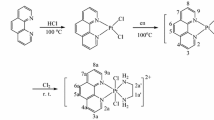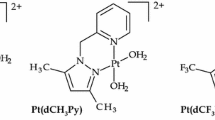Abstract
The redox behaviour of tetrakis(triphenylphosphine)-platinum(0) [Pt(TPP)4], tetrakis(triphenylphosphine)-palladium(0) [Pd(TPP)4] and tetrakis(triphenylphosphine)-nickel(0) [Ni(TPP)4] has been studied in N,N-dimethylformamide (DMF), dimethyl sulfoxide (DMSO), acetonitrile (AN), propanediol carbonate (PDC), N,N-dimethylthioformamide (DMTF) N-methylpyrrolidine-2-thione (NMTP) and nitromethane (NM). The platinum complex was found to undergo irreversible two electron oxidations with partial or complete loss of the ligands in all solvents but nitromethane. The palladium complex was also oxidized to the divalent form in the solvents studied except inPDC andNM where the complex was found to be polarographically inactive; Ni(TTP)4 was reversibly or almost reversibly oxidized to a movovalent form inDMF, AN andDMTF followed by an irreversible oxidation to a divalent complex. Direct oxidation to the divalent form occurred inDMSO, no oxidation was observable inNMTP andPDC, decomposition took place in nitromethane. The half-wave potentials were recorded versus bisbiphenylchromium iodide (BBCr)I as an internal standard. The influence of the solvents on the redox behaviour and the dissociation of ligands is discussed.
Similar content being viewed by others
Literatur
G. Gritzner, P. Rechberger undV. Gutmann, Mh. Chem.107, 809 (1976).
P. Rechberger, Dissertation, Technische Universität Wien (1976).
G. Gritzner, Mh. Chem.107, 1055 (1976).
G. Gritzner, K. Danksagmüller undV. Gutmann, J. Electroanal. Chem.17, 177 (1976).
H. Lehmkuhl, W. Leuchte undW. Eisenbach, Ann. Chem.1973, 692.
H. Lehmkuhl undW. Leuchte, J. Organometal. Chem.1970, 23, C 30.
D. R. Coulson, Inorg. Synth.13, 121 (1972).
R. Ugo, F. Cariati undG. La Monica, Inorg. Synth.11, 105 (1968).
V. Gutmann undG. Peychal-Heiling, Mh. Chem.100, 813 (1969).
K. A. Jensen, Z. anorg. Chem.229, 225 (1936).
G. B. Kauffman undL. A. Teeter, Inorg. Synth.7, 245 (1963).
G. W. Parshall, Inorg. Synth.12, 27 (1970).
G. Gritzner, Mh. Chem.107, 1499 (1976).
Author information
Authors and Affiliations
Additional information
Mit 1 Abbildung
Rights and permissions
About this article
Cite this article
Rechberger, P., Gritzner, G. & Gutmann, V. Einfluß des Lösungsmittels auf das Redoxverhalten von Tetrakis(triphenylphosphin)-platin(0), Tetrakis(triphenylphosphin)-palladium(0) und Tetrakis(triphenylphosphin)-nickel(0). Monatshefte für Chemie 108, 57–64 (1977). https://doi.org/10.1007/BF00900907
Received:
Issue Date:
DOI: https://doi.org/10.1007/BF00900907




